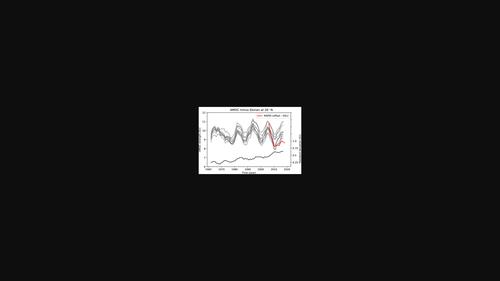1960-2021年海洋温度、盐度与大西洋经向翻转环流的整体重建
IF 3
3区 地球科学
Q2 METEOROLOGY & ATMOSPHERIC SCIENCES
引用次数: 0
摘要
要了解气候变率,初始化和评估年际至年代际气候预测,需要对覆盖数十年的海洋再分析,包括那些观测很少的海洋再分析。英国气象局统计海洋再分析(MOSORA)利用长期协方差,即使从稀疏的观测数据中也能产生月度海洋温度和盐度的全面再分析。我们通过生成一个集合来扩展MOSORA,该集合对长期协方差中的不确定性进行采样。初始协方差取自模型运行,并通过使用迭代过程的观察来改进。我们证明了协方差通过迭代得到了改善,并且该过程使用了20世纪60年代典型的非常稀疏的观测,捕获了受益于现代观测密度的分析的许多特征。我们研究了集合扩展,发现模型运行协方差中的盐度趋势可以在再分析中引入意想不到的变化。我们将重新分析推入耦合气候模式的集合中,以产生对大西洋经向翻转环流(AMOC)的估计。在北纬26°,AMOC表现出与该纬度观测相符的年代际变率,近年来表现出增强的迹象。随着越来越多的观测与不确定协方差相互作用,AMOC重建中的集合扩展随着时间的推移而增加。在45°N, AMOC的年代际变率在各成员之间有所不同,但在较短的时间尺度上,整个整体的变率相似。在45°N时,在西侧边界进行更多的观测可以更好地约束AMOC,但需要更长的连续观测来改善AMOC的协方差,减少AMOC的不确定性。本文章由计算机程序翻译,如有差异,请以英文原文为准。

An ensemble reconstruction of ocean temperature, salinity and Atlantic Meridional Overturning Circulation 1960–2021
Abstract Ocean reanalyses covering many decades, including those with few observations, are needed to understand climate variability and to initialize and assess interannual to decadal climate predictions. The Met Office Statistical Ocean Re‐Analysis (MOSORA) exploits long‐range covariances to generate full‐depth reanalyses of monthly ocean temperature and salinity even from sparse observations. We extend MOSORA by generating an ensemble that samples uncertainties in long‐range covariances. Initial covariances are taken from model runs and these are improved with observations using an iterative process. We demonstrate that covariances are improved by iteration, and that this procedure, using very sparse observations typical of the 1960s, captures many features of analyses benefiting from modern observation density. We investigate the ensemble spread and find that salinity trends in the covariances from model runs can introduce unexpected changes in the reanalyses. We nudge the reanalyses into an ensemble of coupled climate models to produce estimates of the Atlantic Meridional Overturning Circulation (AMOC). At 26°N, the AMOC shows decadal variability consistent with observations at this latitude and shows signs of strengthening in recent years. The ensemble spread in AMOC reconstructions increases with time as more observations interact with uncertain covariances. At 45°N, the amount of decadal variability in the AMOC varies between members, but on shorter timescales the variability is similar across the ensemble. At 45°N, the AMOC can be constrained better with more observations on the western boundary, but longer continuous observations are needed to improve covariances and reduce uncertainties in the AMOC.
求助全文
通过发布文献求助,成功后即可免费获取论文全文。
去求助
来源期刊
CiteScore
16.80
自引率
4.50%
发文量
163
审稿时长
3-8 weeks
期刊介绍:
The Quarterly Journal of the Royal Meteorological Society is a journal published by the Royal Meteorological Society. It aims to communicate and document new research in the atmospheric sciences and related fields. The journal is considered one of the leading publications in meteorology worldwide. It accepts articles, comprehensive review articles, and comments on published papers. It is published eight times a year, with additional special issues.
The Quarterly Journal has a wide readership of scientists in the atmospheric and related fields. It is indexed and abstracted in various databases, including Advanced Polymers Abstracts, Agricultural Engineering Abstracts, CAB Abstracts, CABDirect, COMPENDEX, CSA Civil Engineering Abstracts, Earthquake Engineering Abstracts, Engineered Materials Abstracts, Science Citation Index, SCOPUS, Web of Science, and more.

 求助内容:
求助内容: 应助结果提醒方式:
应助结果提醒方式:


